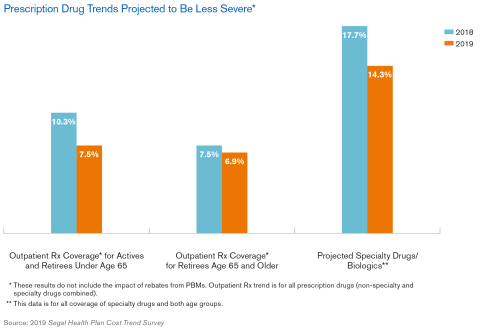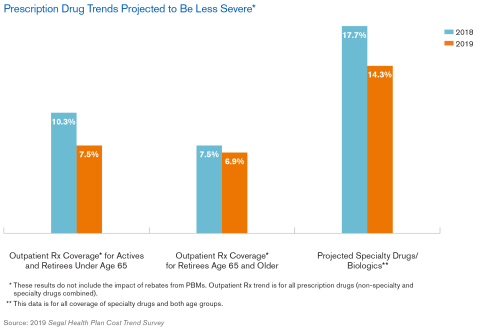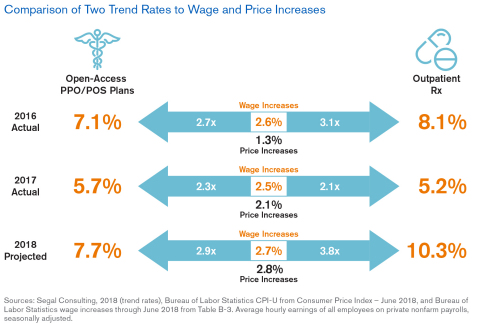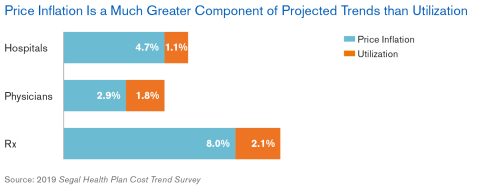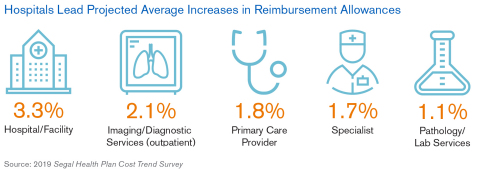NEW YORK--(BUSINESS WIRE)--For 2019, almost all medical plan trends for both active employees and retirees under age 65 are projected to be lower than 2018 projections. (Fee-for-service/indemnity plans are the exception.) Prescription drug cost trends, which have dropped significantly in the last several years, are also projected to be lower. Those are among the key findings of the 2019 Segal Health Plan Cost Trend Survey.
Other key findings are:
- Prescription drug trend is no longer at double digits and is now close to medical cost trend rates.
- However, specialty drugs, which account for more than one-third of total pharmacy spending, are still trending at a double-digit rate.
Edward Kaplan, Segal’s National Health Practice Leader, observes, “Keep in mind that health plan cost increases continue to significantly outpace general inflation and average wage increases. That’s why plan sponsors need to stay vigilant about their cost-management efforts.” He added, “Network physician reimbursement rate increases are projected to increase by less than 2 percent for both primary care and specialists, below overall CPI rates. That suggests value-based care and similar strategies that promote provider accountability and transparency are working.”
The Primary Driver of Trend
The leading driver of trend increases for physician services, hospital services and prescription drugs continues to be price inflation, not utilization.
“Plan sponsors have generally done a good job managing utilization through plan designs that require cost sharing, Mr. Kaplan notes. “Now, many of them are addressing price inflation through various strategies including demanding that networks identify and remove wasteful and overpriced providers.”
Another factor influencing trends is the network-negotiated reimbursement rates paid to providers. Those rates differ from price inflation. Changes in provider reimbursement rates are the result of negotiations between provider groups and health care systems.
Projected Trends Are Typically Higher than Actual Trends
The survey respondents reported actual medical and prescription drug trend results for 2017 (the most recent full year for which actual data is available) that were significantly lower than carrier projections for 2017. In fact, actual prescription drug plan cost trend for 2017 was the second lowest in the last 13 years.
“Although the slowdown in prescription drug plan cost trends is undeniably good news for plan sponsors, their continued focus on managing that significant expense is appropriate. Prescription drugs account for 20 to 25 percent of plans’ annual expenditures,” comments Eileen Flick, senior vice president and Director of Health Technical Services at Segal.
The gap between projected and actual trends for open-access preferred provider organizations/point-of-service plans, which had been closing since 2014, widened in 2017. Projected prescription drug trend, which had been rising since 2014, increased slightly between 2016 and 2017, while actual trend was dramatically lower.
Ms. Flick cautions, “As the economy picks up and overall spending increases, we may start to see the beginning of a reversal of the pattern of downward trends. That’s because, historically, there’s a correlation between a healthy economy and increased utilization of health services.”
Plan Sponsors’ Top Five Cost-Management Strategies
The survey participants ranked the cost-management strategies implemented by group health plans in 2018. The top five are:
1. Using specialty pharmacy management tools or techniques
2. Intensifying pharmacy management program
3. Adding low-cost primary care access
4. Contracting with value-based providers
5. Opioid abuse prevention management
The fact that three of the top five strategies focus on prescription drugs is not surprising given that prescription drug trends outpace medical trends.
This is the 22nd year of Segal’s survey of managed care organizations, health insurers, pharmacy benefit managers and third-party administrators. The survey respondents reported trend forecasts for medical, prescription drug, dental and vision coverage.
To speak with a consultant about health plan cost trends, please contact me.
The Segal Group (www.segalgroup.net) is a private, employee-owned consulting firm headquartered in New York and with more than 1,000 employees throughout the U.S. and Canada. Members of The Segal Group include Segal Consulting, Sibson Consulting, Segal Select Insurance Services, Inc. and Segal Marco Advisors.

